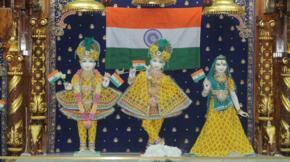Hindola Festival in Swaminarayan Temple

Every year, during the monsoon months of Ashadh and Shravan/ Savan (July–August) the temples are awash with devotion. The Hindola festival is also celebrated in the Savan month in India and around the world. Literally translated, a hindola means a swing.
The Swaminarayan temple in Auckland is also celebrating the Hindola festival with devotees participating in the decorations and preparations every day. Recently, on the occasion of Indian Independence Day, the hindola was made up of the Indian national colours.
The devotees used flowers to make the clothes for Lord Swaminarayan, Lord Krishna and Radha. It took 11 hours and a team of 50 people—over half of which were local and international students—to meticulously sew, glue and bind the flowers and florae together.
The arrival of the Hindola Utsav during these months usher a new breeze of bhakti and festivity in the temples of India. For one whole month, the chal (mobile) murti of the Lord is placed in a hindola and pulled to and fro with a string.
The festival finds its origin in the streets of Vrundavan 5,000 years ago where the Gopis rocked Lord Krishna on a decorated swing. Ever since, to experience the divine joy of rocking the mighty Lord in a small swing, the hindola festival became the focus of devotion.
Today, in memory of the Lord’s divine sports, the hindola festival is celebrated with joy and enthusiasm at all Swaminarayan temples. It is an aesthetic experience of devotion to the Lord, requiring meticulous preparation by sadhus and devotees to produce hindolas of a variety of colours, shapes and forms.
Every year, during the monsoon months of Ashadh and Shravan/ Savan (July–August) the temples are awash with devotion. The Hindola festival is also celebrated in the Savan month in India and around the world. Literally translated, a hindolameans a swing.
The Swaminarayan temple in Auckland is...
Every year, during the monsoon months of Ashadh and Shravan/ Savan (July–August) the temples are awash with devotion. The Hindola festival is also celebrated in the Savan month in India and around the world. Literally translated, a hindola means a swing.
The Swaminarayan temple in Auckland is also celebrating the Hindola festival with devotees participating in the decorations and preparations every day. Recently, on the occasion of Indian Independence Day, the hindola was made up of the Indian national colours.
The devotees used flowers to make the clothes for Lord Swaminarayan, Lord Krishna and Radha. It took 11 hours and a team of 50 people—over half of which were local and international students—to meticulously sew, glue and bind the flowers and florae together.
The arrival of the Hindola Utsav during these months usher a new breeze of bhakti and festivity in the temples of India. For one whole month, the chal (mobile) murti of the Lord is placed in a hindola and pulled to and fro with a string.
The festival finds its origin in the streets of Vrundavan 5,000 years ago where the Gopis rocked Lord Krishna on a decorated swing. Ever since, to experience the divine joy of rocking the mighty Lord in a small swing, the hindola festival became the focus of devotion.
Today, in memory of the Lord’s divine sports, the hindola festival is celebrated with joy and enthusiasm at all Swaminarayan temples. It is an aesthetic experience of devotion to the Lord, requiring meticulous preparation by sadhus and devotees to produce hindolas of a variety of colours, shapes and forms.









Leave a Comment